What are the common causes of back pain?
One of the most common and costly conditions that we see in the clinic is low back pain (LBP). We breakdown all the common conditions and share safe exercise tips.
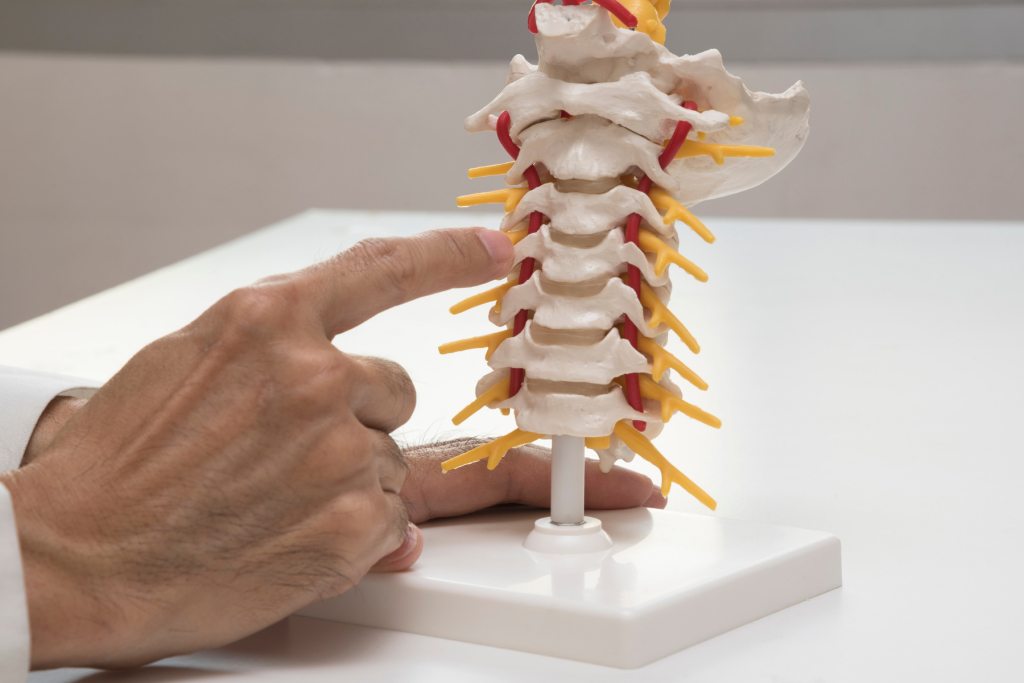
One of the most common and costly conditions that we see in the clinic is low back pain (LBP). Whether this is acute or chronic, a large majority of our clients, at one point or another, have experienced low back pain in their lives. The United States is estimated to spend approximately $90 billion annually on the treatment of LBP (this includes MD visits, imaging, surgery, PT, among other treatments), and has also become the number one condition of disability among industrialized nations. So: what should you do if you start to experience low back pain, or have had chronic low back pain?
Basic Anatomy of the Spine
First, let’s explore the basic anatomy of the spine. Your spine is made up of four regions: cervical (seven vertebrae), Thoracic (12 vertebrae), Lumbar (five vertebrae), and Sacral (five fused vertebrae). Each of these regions have slightly different shapes, curves, and structures that allow for different types of movements and protection at each region.
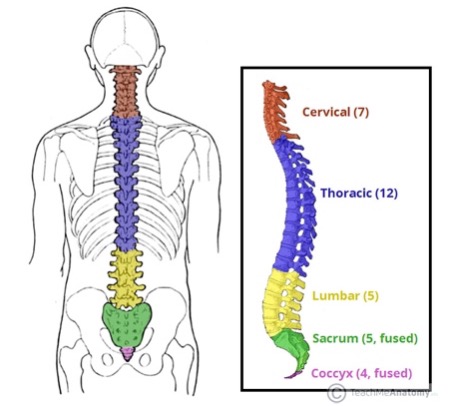
Each vertebra is separated by the intervertebral disc. The disc is made of two main structures, the annulus fibrosus and the nucleus pulposus. The nucleus pulposus is the inner gelatinous portion which will resist compressive forces though the spine, and the annulus fibrosus is the outer ring of the disc, which resists more tensile forces. Together, these two structures help decompress the spine and provide padding between the vertebrae to allow for movement of the spine.
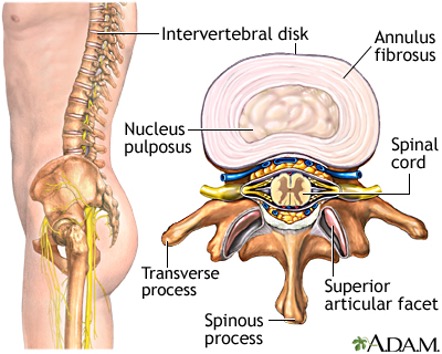
Another role of the vertebrae, besides movement, is to protect the spinal cord and corresponding nerve roots from damage. As you can see from this top-down view, the spinal cord is protected within the vertebral foramen. The nerve roots, which will supply the muscles and provide sensation to the extremities, are also protected in the lateral foramen
There are also many muscles that help provide support and stability to the spine. When people think of the “core,” often times we only consider the abdominal musculature (obliques, transverse abdominus, rectus abdominus). While these are important to spine health, the core is a very comprehensive term, and can encompass your abdominals, erector spinae, deep spinal stabilizers, and even your glutes.
There are also many muscles that help provide support and stability to the spine. When people think of the “core,” often times we only consider the abdominal musculature (obliques, transverse abdominus, rectus abdominus). While these are important to spine health, the core is a very comprehensive term, and can encompass your abdominals, erector spinae, deep spinal stabilizers, and even your glutes.
Common Injuries and Conditions
There are many different structures and conditions that can produce pain in the lower back. Here, we have outlined a few of the most common ones, and symptoms associated with them:
Discogenic Pain: Discogenic pain is caused by injury to the intervertebral disc, usually the annulus fibrosus (outer portion), which then causes pain. Pain is typically in the lower back, but can also radiate into the buttock and leg. Commonly, pain will increase with bending forward, prolonged sitting, lifting, and even coughing or sneezing.
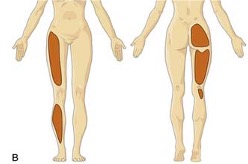
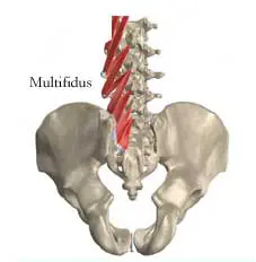
Muscle Strains: Like any other part of your body, you can strain a muscle in your lower back. Often, this is an acute event with a clear mechanism of injury. While this can feel similar to discogenic pain, this often does not radiate into the leg like a disc injury. Pain will increase when bending over fully (mostly pain at the end of your motion), pain when returning from that position (this activates the strained muscle), and generally pain with resisted testing and active motion.
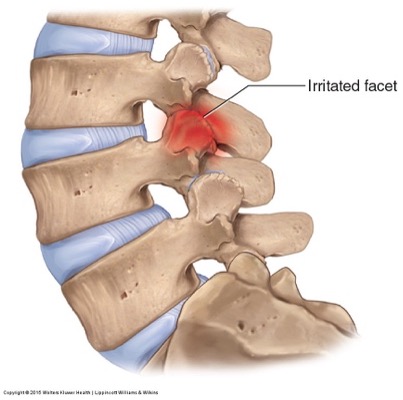
Facet Mediated Pain: The facet joints are another articulation between corresponding vertebrae that can be a pain generator in the lower back. These joints are highly innervated by the nerves, and thus can cause pain when there is irritation. Pain will be in the back and can radiate into the buttock, and increases when extending and rotation on your spine (i.e. turning to look over your shoulder)
Disc Herniation: Disc herniations happen when nucleus pulposus (inner portion) is displaced from the intervertebral space, and can then compress on the nerve root, causing pain or neurological symptoms. You may experience burning, stinging, or shooting pain in the back and/or leg, and also may notice diminished sensation or weakness in the leg.

Degenerative Disc Disease: As we age, the intervertebral discs start to lose water content and become less resistant to compressive load. While this is a normal process, it can still cause pain and dysfunction. This process leads to decreased disc height, which can then lead to issues like stenosis or facet joint pain.
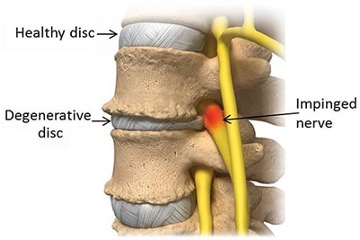
Stenosis: Narrowing of the canal where either the spinal cord (central stenosis) or nerve roots (foraminal stenosis). This can be due to degenerative changes of the disc and spine that lead to decreased space for the nerve to exit. This then leads to pain in the lower back and/or into the leg, and similar to a disc herniation, can have numbness and tingling, weakness, or decreased sensation. Pain typically gets worse with extending the spine, and improves when flexing forward (this opens of the space where the nerve exits, thus relieving symptoms).

Stress Reactions and Stress Fractures (Spondylolysis): Stress reactions and fractures are common in the younger population, and affects a structure known as the pars interarticularis. This is the weakest part of the vertebrae, so is the first to be damaged. Overload of the pars interarticularis leads to a stress reaction at the pars; and If untreated or undiagnosed, can lead to stress fracture. Pain is sharp and focal and will increase with extension and rotation-based activities.
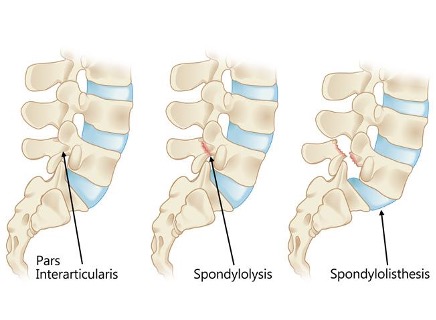
Scoliosis: Scoliosis is an abnormal curvature of the spine. Primary age of onset of 10–15 years old, with females being more affected than males. There are two main types of scoliosis, structural and functional. Structural is actual structural abnormalities of the spine causing the curve, while functional is more a result of posture and muscular imbalances that cause an apparent curve in the spine.

What should you do if you start to get back pain?
If you start to get lower back pain, there are a few things to consider in order to make a good decision on your next steps:
- When did the pain start?
- Was there a clear mechanism of injury?
- Where is your pain? (just the back, into the leg, etc.)
- Have you previously hurt your back? And if so, was this similar?
- Do you have any pain, numbness, or tingling going into your legs?
- What movements, activities, or exercises make the pain worse? Which make it better?
If your pain seems to be more than “just an ache,” you should also consider reaching out to a physical therapist for a full evaluation. A physical therapist can perform an in-depth evaluation consisting of a thorough medical history, screening for any potential red flags, and a comprehensive movement assessment in order to figure out what the root cause of your pain is. From that evaluation, we can help to guide you in the right direction. Some may only need a program for self-management, while others may need manual therapy to reduce pain and improve their mobility before jumping into strengthening. Depending on your symptoms and presentation, the therapist may also refer you to a doctor who specializes in treatment of your condition, and will huddle with them to provide the best care possible.
Can I keep exercising? What should I be doing?
Yes! Most of our research shows that regular exercise, including walking, is extremely helpful for dealing with low back pain. Your body functions better when it is moving, as this releases dopamine and endorphins that can actually help your body deal with the pain.
Tips for exercising with LBP:
Safe and effective programming: Make sure that your exercise program is tailored towards your capabilities, injury history, and most importantly your goals. Every session should have a purpose, and should help maximize your time in the gym. Our personal trainers have extensive backgrounds in exercise programming, and will help to create the right program to help you meet your goals.
Quality over quantity: We’re all guilty of this, trying to go for a new one rep max or get the last rep in, even if it means sacrificing form. As you are working out, put more emphasis on your form, making sure that you maintain good posture and are feeling the exercise in the right place. Sacrificing form for more weight/reps can often lead to injury or exacerbation of an old injury.

Michael Semancik
Michael Semancik, DPT, TPI-M1, is a physical therapist and certified dry needling specialist who works with young athletes, specifically with rowers, hockey players and football players.
RECENT POSTS
CATEGORIES

> Privacy Practices
> Terms and Conditions
Copyright © Performance 2022.
All rights reserved.
JOIN OUR COMMUNITY
Sign up for our mailing list to learn more about Performance, stay up-to-date on our offerings, and receive our newsletter.
Digital Marketing by Rebel Interactive Group
